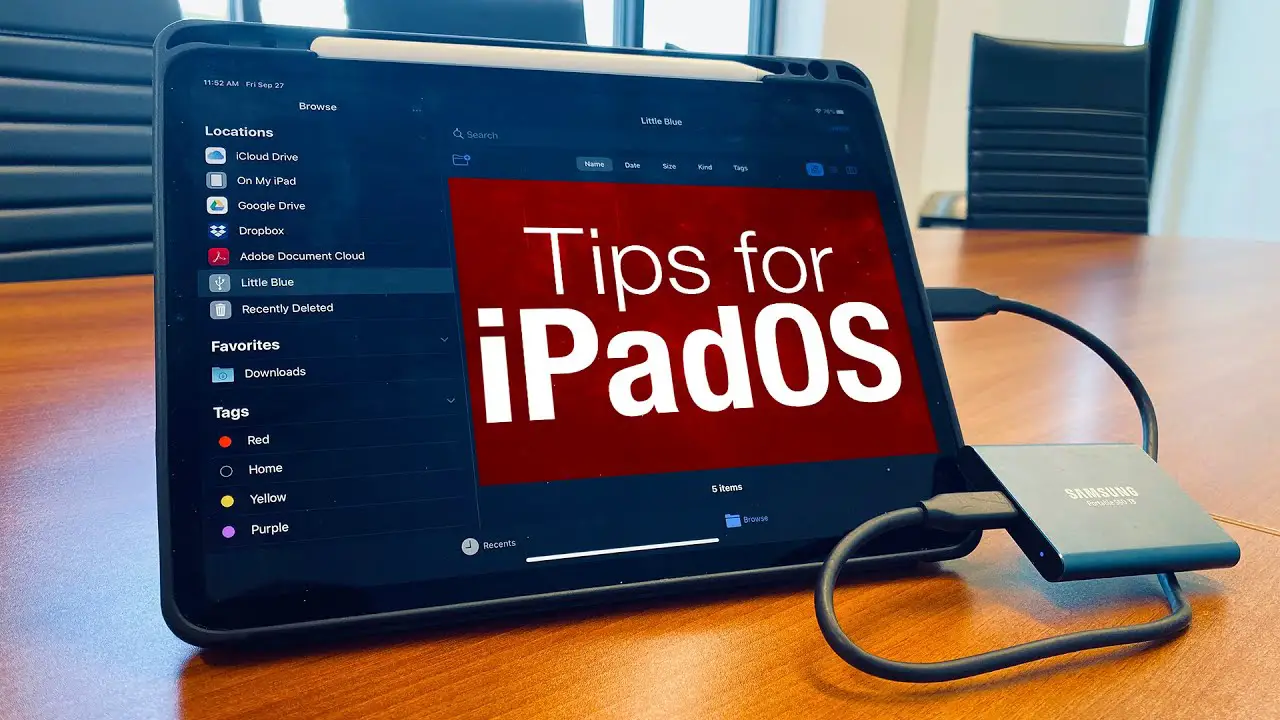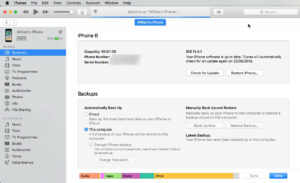Can You Use External Ssd With Ipad Pro? Yes!
Yes, with the introduction of iPadOS 13, Apple has enabled support for external SSDs which allows users to connect the SSDs directly to an iPad Pro through the USB-C port.
Through iPadOS 13 and later versions, Apple has expanded the file management capabilities of the iPad Pro. Users can connect an external SSD to their iPad Pro using the USB-C port.
Once connected, they can directly access files and documents stored on the SSD using the Files app on the iPad. This allows for easier and more efficient file management and sharing.
The integration of external SSD support with iPad Pro has transformed the way users manage and access their files.
This is a significant leap towards making the iPad Pro a more powerful and versatile device, capable of handling more complex file management tasks traditionally reserved for laptops and desktops.
Users no longer need to rely on cloud-based solutions for storage, they can access, edit and save their files directly from an SSD.
This denotes that Apple is continuously working to bridge the gap between the iPad Pro and more traditional computing devices.
9 Benefits of Using External SSD with iPad Pro
| Feature | Description |
|---|---|
| Compatibility | Yes, the iPad Pro is compatible with external SSDs. |
| Required iPadOS | iPadOS 13 and later versions have support for external drives. |
| Connection Type | USB-C connection type is needed for direct plug-in. For other connection types, an adapter may be required. |
| File System Support | iPad Pro supports SSDs formatted with FAT32, ExFAT, HFS+, and APFS file systems. |
| File Access | Files app on the iPad Pro is used to access files on the SSD. |
| Power Requirements | Some SSDs may require a separate power source due to the iPad Pro’s power limitations. |
| Limitations | Some SSDs may not work flawlessly due to power restrictions or compatibility issues. |
| Notable Supported SSDs | Samsung T5, SanDisk Extreme Portable SSD, Crucial X8, etc. |
| Use Cases | For expanding storage, backup, or transferring large files. |
Key Takeaway

Five Facts About: Using External SSD With I pad Pro
Benefits Of Using An External Ssd With Ipad Pro
Using an external SSD with iPad Pro offers numerous benefits. It allows you to significantly expand your storage capacity, enjoy faster data transfer speeds, and seamlessly access and edit large files on the go, enhancing your productivity and efficiency.
The iPad Pro is a powerful device that offers a range of features and capabilities. However, one limitation of the device is its storage capacity.
Fortunately, you can overcome this limitation by using an external SSD (Solid State Drive) with your iPad Pro.
This allows you to expand your storage, enhance performance, and enjoy increased accessibility and portability.
Below, we explore the specific benefits of using an external SSD with your iPad Pro.
Increased Storage Capacity
- External SSDs provide additional storage capacity for your iPad Pro, allowing you to store more files, documents, photos, and videos.
- With an external SSD, you no longer have to worry about running out of storage space on your device, giving you peace of mind when it comes to managing your digital content.
Enhanced Performance
- An external SSD significantly improves the performance of your iPad Pro, allowing for faster file transfers and smoother data access.
- With the faster read and write speeds of an SSD, you can enjoy seamless multitasking, quicker app launches, and enhanced overall performance on your iPad Pro.
Accessibility And Portability
- Using an external SSD with your iPad Pro offers enhanced accessibility and portability, as you can easily access your files from anywhere and anytime.
- With the ability to connect your external SSD to your iPad Pro, you can have access to all your important files, whether you are at home, in the office, or on the go.
- External SSDs are compact and lightweight, making them easy to carry along with your iPad Pro, allowing you to have your storage solution always within reach.
Utilizing an external SSD with your iPad Pro provides a multitude of benefits. From increased storage capacity to enhanced performance and improved accessibility and portability, an external SSD is a valuable addition to your device setup.
Expand your storage, optimize your performance, and enjoy the convenience of having all your files accessible wherever you go.
Compatibility And Setup
Using an external SSD with iPad Pro is a breeze, thanks to its compatibility and easy setup. Enjoy the benefits of expanded storage and faster performance for all your digital needs. Bring your workflow to the next level with this seamless combination.
External SSDs are a popular choice for expanding the storage capacity of iPad Pro devices. They offer fast data transfer speeds and enable users to store a large amount of data without occupying internal storage.
To help you understand how to use an external SSD with your iPad Pro, we will explore the following topics:
Compatible External Ssds For Ipad Pro
Before connecting an external SSD to your iPad Pro, it’s essential to ensure that it is compatible with your device.
Here are some reliable external SSD options that work seamlessly with iPad Pro:
- Samsung T5: With its compact design and lightning-fast transfer speeds, the Samsung T5 is highly compatible with iPad Pro.
- SanDisk Extreme: Known for its ruggedness and high performance, the SanDisk Extreme external SSD is a reliable choice for iPad Pro users.
- Seagate One Touch: This portable external SSD delivers excellent performance while maintaining a sleek and compact design.
Connecting External Ssd To Ipad Pro
To connect an external SSD to your iPad Pro, follow these steps:
- Step 1: Ensure that your iPad Pro is running the latest iOS version. This ensures compatibility and optimal performance.
- Step 2: Use a USB-C to USB-C cable or a USB-C to USB-A adapter, depending on the connectivity options of your external SSD and iPad Pro.
- Step 3: Connect one end of the cable or adapter to the external SSD and the other end to the corresponding port on your iPad Pro.
- Step 4: Once connected, your iPad Pro should recognize the external SSD and prompt you to allow access.
Configuring External Ssd On Ipad Pro
After connecting the external SSD to your iPad Pro, you may need to configure it for optimal usage.
Below are some steps to help you get started:
- Step 1: Open the Files app on your iPad Pro. This app allows you to manage and access files from various sources, including external storage devices.
- Step 2: Locate the external SSD under the “Locations” section in the Files app. Tap on the SSD’s name to access its contents.
- Step 3: If necessary, create new folders or organize existing files on the external SSD to suit your needs.
- Step 4: You can also use the “On My iPad” section in the Files app to transfer files between your iPad Pro’s internal storage and the external SSD.
By following these simple steps, you can seamlessly integrate an external SSD with your iPad Pro and enjoy expanded storage capacity.
Whether you’re a creative professional or a power user, an external SSD can significantly enhance your productivity and storage capabilities on an iPad Pro.
Maximizing External Ssd Performance On Ipad Pro
Maximize the performance of your iPad Pro by using an external SSD. Unlock the full potential of your device with faster data transfer speeds and expanded storage capacity for all your files and apps.
With the increasing demand for powerful and portable devices, the iPad Pro has emerged as a versatile tool for professionals on the go.
Adding to its appeal is the ability to connect an external SSD, allowing users to expand storage and enhance performance.
In this section, we will explore how to optimize file transfer speeds, manage storage space efficiently, and organize files and folders effectively when using an external SSD with the iPad Pro.
Optimizing File Transfer Speeds:
- Connect the external SSD to the iPad Pro using a compatible adapter or cable.
- Ensure that the external SSD is formatted to a compatible file system such as ExFAT for seamless integration with the iPad Pro.
- Use a high-quality USB-C cable or adapter to ensure fast data transfer rates.
- Close unnecessary apps and background processes on the iPad Pro to allocate more resources for file transfer.
- Consider using specialized file management apps like Files by Apple or Documents by Readdle for optimized file transfer speeds.
Managing Storage Space:
- Regularly review and remove any unnecessary files or duplicates from the external SSD to free up storage space.
- Transfer large media files like videos or photos to the external SSD to save internal storage space on the iPad Pro.
- Utilize cloud storage services like iCloud or Google Drive to store files that aren’t frequently accessed, reducing the load on the external SSD and iPad Pro.
- Consider compressing files or using file compression apps to save additional storage space on the external SSD.
- Keep track of available storage space on both the external SSD and the iPad Pro to prevent any unexpected data transfer issues.
Organizing Files And Folders:
- Create separate folders or categories on the external SSD to organize files efficiently.
- Use descriptive and easily recognizable names for folders to locate desired files quickly.
- Implement a file naming convention to maintain consistency and ease of navigation.
- Utilize tags or labels to further categorize files and improve searchability.
- Regularly backup and sync files between the external SSD and the iPad Pro to avoid any data loss.
By following these tips, you can maximize the performance of an external SSD when using it with an iPad Pro.
Whether you are transferring files, managing storage, or organizing your data, these guidelines will ensure a seamless experience, allowing you to take full advantage of the power and versatility of iPad Pro and external SSD combination.
Best Practices For Using External Ssd With Ipad Pro
Discover the best practices for utilizing an external SSD with your iPad Pro. Explore the possibilities of using external storage to expand your device’s capabilities and enhance your productivity on-the-go.
If you’re looking to expand the storage capacity of your iPad Pro, using an external SSD is a great option.
Not only does it provide ample space for your files and data, but it also offers faster transfer speeds compared to traditional external hard drives.
To ensure a smooth and optimal experience, here are some best practices to keep in mind when using an external SSD with your iPad Pro.
Safely Ejecting External Ssd:
When you’re finished using your external SSD with your iPad Pro, it’s crucial to safely eject the device to prevent data loss or corruption.
Follow these steps to safely eject your external SSD:
- Locate the external SSD icon on your iPad Pro.
- Tap and hold the icon until a contextual menu appears.
- Select “Eject” to safely disconnect the external SSD from your iPad Pro.
Remember, it’s always better to be safe than sorry. Safely ejecting your external SSD ensures that all pending write operations are completed and your data remains intact.
Backup And Data Security:
Data security should be a top priority when using an external SSD with your iPad Pro.
To safeguard your important files and prevent any data loss, consider the following best practices:
- Regularly back up your external SSD to another storage device or cloud service.
- Enable file encryption on your external SSD to protect sensitive data.
- Use strong and unique passwords to secure your external SSD.
By implementing these practices, you can ensure that your files are protected and accessible even in the event of data loss or theft.
Updating External Ssd Firmware:
To improve performance and address any potential bugs or issues, it’s essential to keep your external SSD firmware up to date.
Follow these steps to update your external SSD firmware:
- Check for firmware updates on the manufacturer’s website or using their dedicated software.
- Download the latest firmware version for your specific external SSD model.
- Connect your external SSD to your iPad Pro and follow the manufacturer’s instructions to update the firmware.
Updating the firmware of your external SSD ensures that you have the latest features and enhancements available, providing an optimized experience.
Using an external SSD with your iPad Pro can greatly enhance your storage capacity and productivity.
By following these best practices of safely ejecting the device, backing up your data, and updating the firmware, you can maximize the benefits of using an external SSD with your iPad Pro.
Remember to always prioritize data security and maintain regular backups to keep your files safe.
FAQ About Can You Use External Ssd With Ipad Pro
Can I use an external SSD with my iPad Pro?
Yes, you can use an external SSD with your iPad Pro. You will need a USB-C or Lightning to USB-C adapter to connect the drive to your iPad, and you can then access the contents of the drive via an app like File Browser.
What type of external SSD can I use with my iPad Pro?
You can use any external SSD that has a USB-C or Lightning to USB-C connection.
How do I connect my external SSD to my iPad Pro?
To connect your external SSD to your iPad Pro, you will need to use a USB-C or Lightning to USB-C adapter.
Once connected, you can access the contents of the drive with an app like File Browser.
Can I use my external SSD to store files on my iPad Pro?
Yes, you can use your external SSD to store files on your iPad Pro. You can access the contents of the drive with an app like FileBrowser, and you can then move files to and from your iPad.
Conclusion
The integration of external SSDs with iPad Pro has opened up new possibilities for users seeking expanded storage and improved performance.
With the right adapter, you can easily connect your iPad Pro to an external SSD and enjoy the benefits of faster transfer speeds, increased storage capacity, and seamless file management.
Whether you are a professional who needs to work with large media files or a student looking to access and save a wide range of data on the go, using an external SSD with iPad Pro can greatly enhance your productivity and efficiency.
It allows you to effortlessly transfer files, stream high-resolution videos, and work on resource-intensive tasks without worrying about storage limitations. Take advantage of this technology and unlock the full potential of your iPad Pro.
Embrace the power of portability and flexibility with the use of an external SSD for your iPad Pro.






